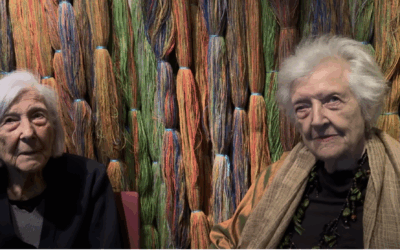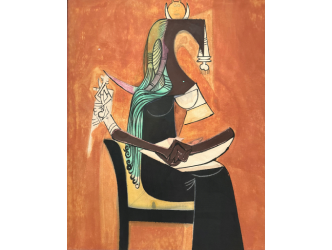Panorama Pozzuoli
At a time when the art market is caught in a chasm of pessimism, a small four-day event in Italy breathed new life into the idea of the fair, animated by a fresh and invigorating spirit. Here there were no million-dollar deals, no glamorous venues, no wild parties with bimbos. From September 10 to 14, forty-five galleries based in Italy presented 110 works by 47 artists in Pozzuoli, a chaotic small town on the outskirts of Naples for Panorama Pozzuoli.
The power of art
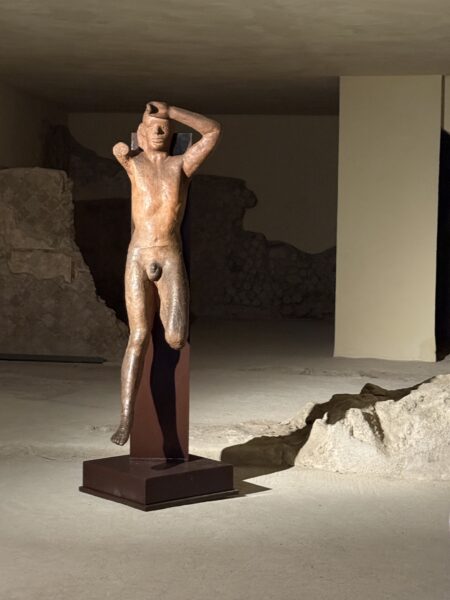
Marino Marini (Maria Tersa Tosi gallery)
Lorenzo Fiaschi
The idea of commerce was certainly present, since the initiative was organized by galleries, but the priority was given to the power and the virtues of art. The scope was broad, from ancient sculpture to contemporary painting. Panorama—an annual travelling project since 2021—was conceived during Covid by two dealers, Lorenzo Fiaschi (Galleria Continua) and Pepi Marchetti Franchi (Gagosian), as a way of breaking out of isolation. Since then it has been staged deliberately in places where art can act as a social catalyst.
Pozzuoli
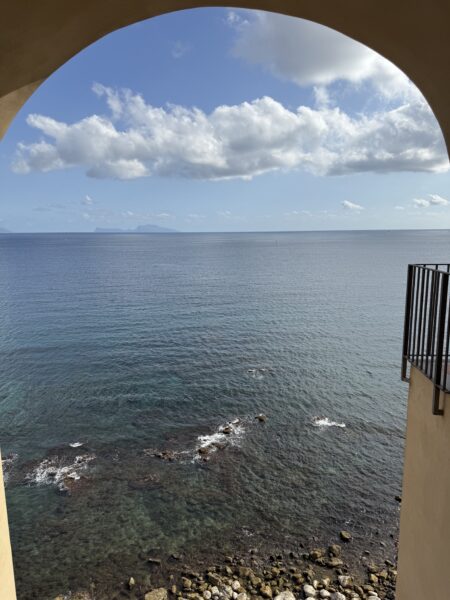
Pozzuoli
Pozzuoli (population 80,000) lies on the edge of the Bay of Naples, rich in ancient remains and famous as the childhood home of Sophia Loren. Yet it is little known to tourists. At its summit is Rione Terra, the old fishermen’s quarter with breathtaking views. Emptied of its residents by force in the 1970s, later restored but never repopulated, it has now become the center of Panorama. The town, with its generally run-down appearance, is regularly shaken by earthquakes of varying magnitude.
Chiara Parisi
For the 2025 edition, the curator was Chiara Parisi—who also directs the Centre Pompidou Metz—taking “deification” as her guiding theme. What stood out most was the participation of the local community. A troop of high-school students zealously served as guides and mediators. Over the weekend, local visitors in effect reclaimed Rione Terra for themselves.
Pepi Marchetti Franchi
“By involving the young, we plant a seed that can change everything—it allows people to learn to embrace differences,” explained Lorenzo Fiaschi.
As for the commercial side of the project, Pepi Marchetti Franchi remarked: “It is becoming harder and harder to draw collectors into galleries. Here we are offering another kind of experience. And after all, it is not unusual for works to sell at biennales. Why not here?” . The model is hybrid, somewhere between a Monumenta (those sprawling bienniale exhibitions staged in cities such as Marseille or Palermo) and a fair like the one planned in Doha, Qatar, on February 5–7, 2026, with sixty galleries, entirely curated by the artist Wael Shawky.
Audrey Azoulay
From the outset the initiative has enjoyed the patronage of Audrey Azoulay, UNESCO’s director general, who came to Pozzuoli herself: “This was exactly the kind of artistic initiative that was missing. Here, galleries have come together to invest in a city, establishing a dialogue between artists and the population. This is precisely what we are looking for.” Funding came not only from the galleries but also from municipal and regional authorities.
Maurizio Cattelan
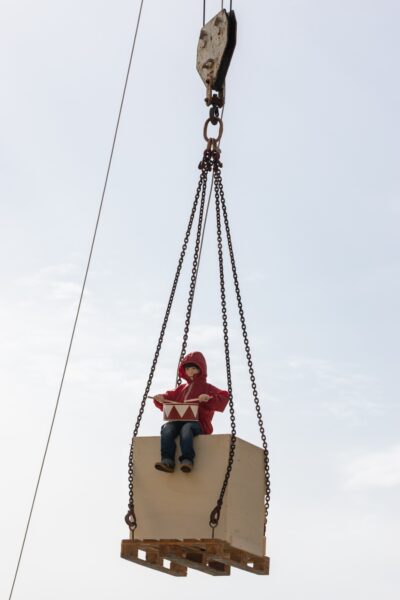
Maurizio Cattelan
Chiara Parisi built her project around artists represented by participating galleries. She has close ties with Maurizio Cattelan—whose exhibition she is currently hosting at the Centre Pompidou Metz—and invited him to discover the site of Pozzuoli, where he came up with a proposal for the occasion. One of the emblematic pieces of Panorama was a small animatronic figure, a drummer suspended high above the city by a crane imagined in 2003 by Cattelan. A town crier who never brings the awaited news, but instead disturbs the townspeople—like the hero of The Tin Drum, the novel by Günter Grass brilliantly adapted for cinema in 1979 by Volker Schlöndorff.
This work, which travelled specially from Dallas, belongs to the Rachofsky Collection and was not for sale.
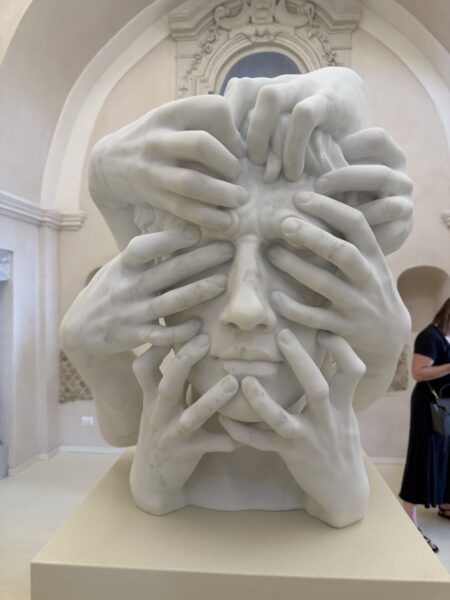
Maurizio Cattelan
By contrast, a marble sculpture from 2025 entitled Virus—a face surrounded by countless intrusive hands that blind it—was being shown for the first time.
Ugo Rondinone
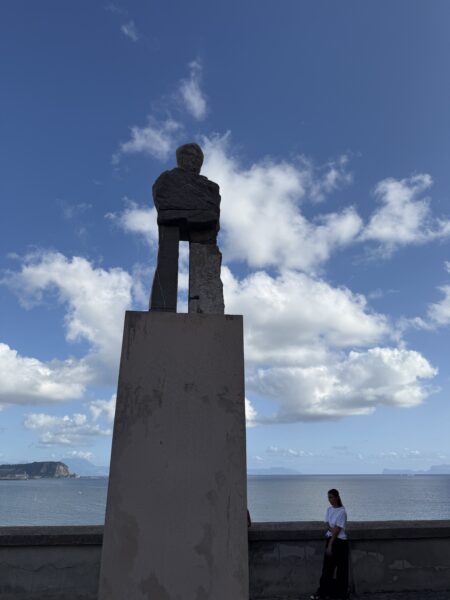
Ugo Rondinone
Another emblematic work was an archaic looking sculpture: an aggregate of unpainted stones forming a kind of divinity from some unknown cult from the past. The characteristic mound unmistakably identified the swiss italophone artist Ugo Rondinone. His work The first (2025) was installed in a strategic square overlooking the town and the sea by Alfonso Artiaco, a gallerist born in Pozzuoli and long based in Naples.
“Naples has a great tradition of interest in contemporary art,” Artiaco remarked.
Franco Noero
Just opposite, in the majestic Sedile dei Nobili of 1623—where the city’s nobles once met—the gallery Franco Noero presented in an oval chamber a double daguerreotype engraving (2025) of a Caravaggio painted in Naples.
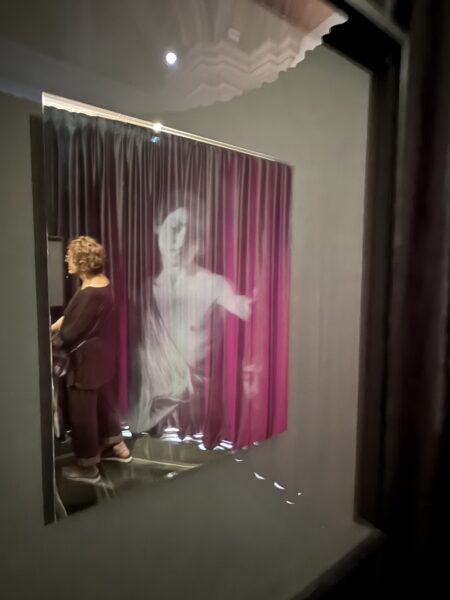
Simon Sterling
Its author, the British artist Simon Sterling, used this fascinating process, more than just the ancestor of photography: a mirrored, elusive object.
Simone Fattal
Milan’s Kaufmann Repetto showed three bronze sculptures by the Syrian-born, Paris-based artist Simone Fattal—semi-abstract figures of ancient deities—within the extraordinary Flavian Amphitheater, which in the first century could hold nearly 20,000 spectators.
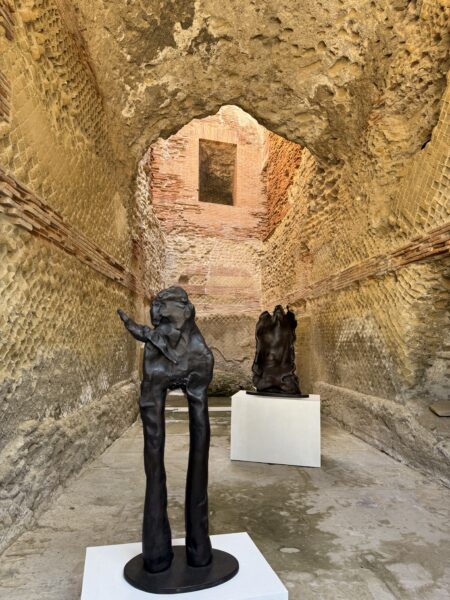
Simone Fattal
In 2024 Fattal had been presented in a similar spirit among the antiquities of the Louvre.
William Kentridge
Panorama also extended nine kilometers away to the little-known Archaeological Park of Cuma, where legend places the Cumaean Sibyl, uttering her oracles at the end of a long underground passage. This is the same Sibyl evoked in William Kentridge’s 2020 video, here projected with striking effect inside the ancient grotto.
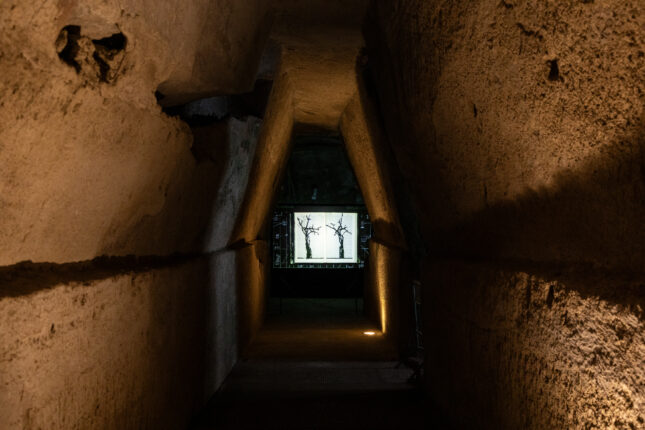
William Kentridge
“It is wonderful to conclude this journey precisely where the Sibyl delivered her oracles,” Chiara Parisi remarked, unfazed by the fleeting nature of the event. “It is a concentration of exceptional energy in which everyone comes together—residents mingling with visitors who have come especially for the occasion.”
Support independent art journalist
If you value Judith Benhamou Reports, consider supporting our work. Your contribution keeps JB Reports independent and ad-free.
Choose a monthly or one-time donation — even a small amount makes a difference.
You can cancel a recurring donation at any time.


